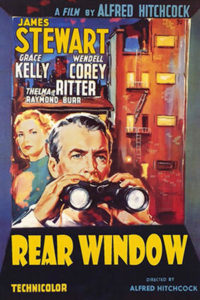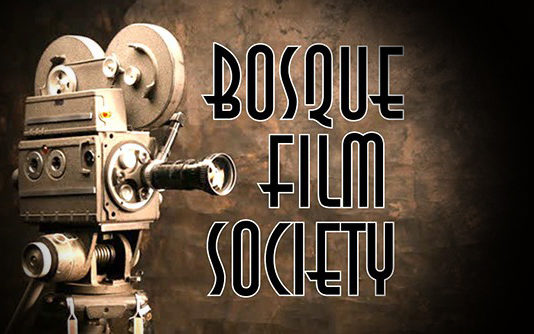COMMENTARY ON SOCIAL VALUES: Alfred Hitchcock’s classic mystery thriller “REAR WINDOW” provokes its audience to examine its own habits, remains relevant in today’s digital & social media world
By KAYE R. CALLAWAY
Bosque Film Society Board Member
Rear Window is a 1954 American mystery thriller film, directed by Sir Alfred Hitchcock and written by John Michael Hayes, based on Cornell Woolrich’s 1942 short story “It Had to Be Murder.” I consider this film similar to a play, with a limited number of characters and locations.
The main cast is James Stewart (Jeff), Grace Kelly (girlfriend Lisa), Wendell Corey (Detective Doyle), Thelma Ritter (nurse Stella), and Raymond Burr (neighbor Thorwald). Jeff is a professional photographer confined to a wheelchair (due to his broken left leg) in his Greenwich Village Manhattan apartment, watching out his rear window a courtyard surrounded by neighboring apartments. He’s visited daily by his socialite girlfriend Lisa and his nurse Stella. I won’t reveal the plot, since some people haven’t seen the film yet.

Rear Window was shot entirely at Paramount Studios with almost a $1 million budget. It took about six weeks to build a detailed and complex courtyard set, the largest of its kind yet. Part of the cost was due to a massive drainage system made for the rain sequence, a nuanced light system for natural-looking lighting effects for both day and night scenes, and natural city sounds, especially music drifting across the courtyard into Jeff’s apartment. We see what Jeff sees and we hear what Jeff hears.
Listen for Bing Crosby singing “To See You Is to Love You,” Nat King Cole singing “Mona Lisa,” Dean Martin singing “That’s Amore,” Richard Rogers’ “Lover,” opera songs, etc. Most songs were borrowed from Paramount’s music publisher. Of course, the costume designer was Edith Head.
The cinematographer was Richard Burks, who left Warner Bros. alongside Alfred Hitchcock as they switched to Paramount Studios. Burks’ amazing chameleon skills in the type of camerawork and visual styling made him one of Hitchcock’s most valuable collaborators in his 50s and 60s movies.
The North American box office run earned $5.3 million and has since earned about $37 million. François Truffaut’s 1954 review suggested, “This is a parable: the courtyard is the world, the reporter/photographer is the filmmaker, and the binoculars stand for the camera and its lenses.” Roger Ebert’s 1983 review of Universal Pictures’ re-release included, “We can’t detach ourselves because we looked too, so we share the guilt and, in a way, we deserve what’s coming to him.” Killian Fox’s (The Guardian) 2012 review says, “Hitchcock made a career out of indulging our voyeuristic tendencies, and he never excited them more skillfully, or with more gleeful self-awareness, than in Rear Window.”
Merely two of many remakes are: 1) the 1998 TV movie using the same name with an updated storyline with the lead roles by Christopher Reeve after his 1995 paralyzing horse-riding accident and Daryl Hannah; and 2) the 2007 movie Disturbia a modern-day retelling of the story with Shia LaBeouf as the main character. The Sheldon Abend Trust sued Steven Spielberg, DreamWorks, Viacom, and Universal Studios, alleging the producers violated the copyright of the original Woolrich story owned by Abend in 2008, and in 2010, the U.S. District Court ruled that Disturbia did not infringe the original Woolrich story [Abend v. Spielberg, 748 F.Supp.2d 200 (S.D.N.Y 2010)].
Trivial entertainment data found on MentalFloss.com begins with watching for Hitchcock’s cameo as he winds the Songwriter’s apartment clock and turns his face toward our view as he mutely chats. As John Michael Hayes wrote the screenplay, Hitchcock helped create the actual crime based partly on two prior British crimes he found, the 1910 case of Dr. Hawley Crippen and the 1924 case of Patrick Mohan.
Grace Kelly apparently turned down the lead in On the Waterfront to star in Rear Window. The On the Waterfront role went to Eva Marie Saint. Grace Kelly became Princess Grace two years later, in 1956 when she married Prince of Monaco Rainier III. In 1959, Hitchcock chose Eva Marie Saint for the blond role in North by Northwest.

Character Miss Torso was a 17-year-old teenage ballerina who had moved to California to pursue ballet. Sadly, she didn’t follow Hitchcock’s advice to find an acting agent and was paid only $350 for her work. Character Songwriter was played by Ross Bagdasarian, an actual pianist and composer. In 1958, he created Alvin and the Chipmunks and recorded “The Chipmunk Song,” achieving other fame. Characters Jeff & Lisa’s romance may have been somewhat based on the real-life Ingrid Bergman’s affair with Robert Capa while Hitchcock filmed her in Notorious. Capa was a famous photojournalist who had lived in Greenwich Village. Terribly, he stepped on a landmine in May 1954, destroying his entire left leg.
Hitchcock intentionally told the character couple who often sleep on the fire escape separately to pull the mattress in opposite directions. When it starts raining, they unexpectedly struggle enough that he accidentally falls into their window. Hitchcock loved it enough to keep it in the movie.
ChinaRhyming.com explains details in the last scene. Lisa reads William O Douglas’s book Beyond the High Himalayas until Jeff falls asleep. Why that book? Well, Jeff’s scratched cigarette box while in Shanghai blends well with the Himalayas. Douglas was currently a liberal Supreme Court Justice who loved traveling, and his book had been published in 1952. Connections never hurt. And as soon as Lisa’s confident Jeff’s sleeping, she switches to her Harper’s Bazaar fashion magazine.
